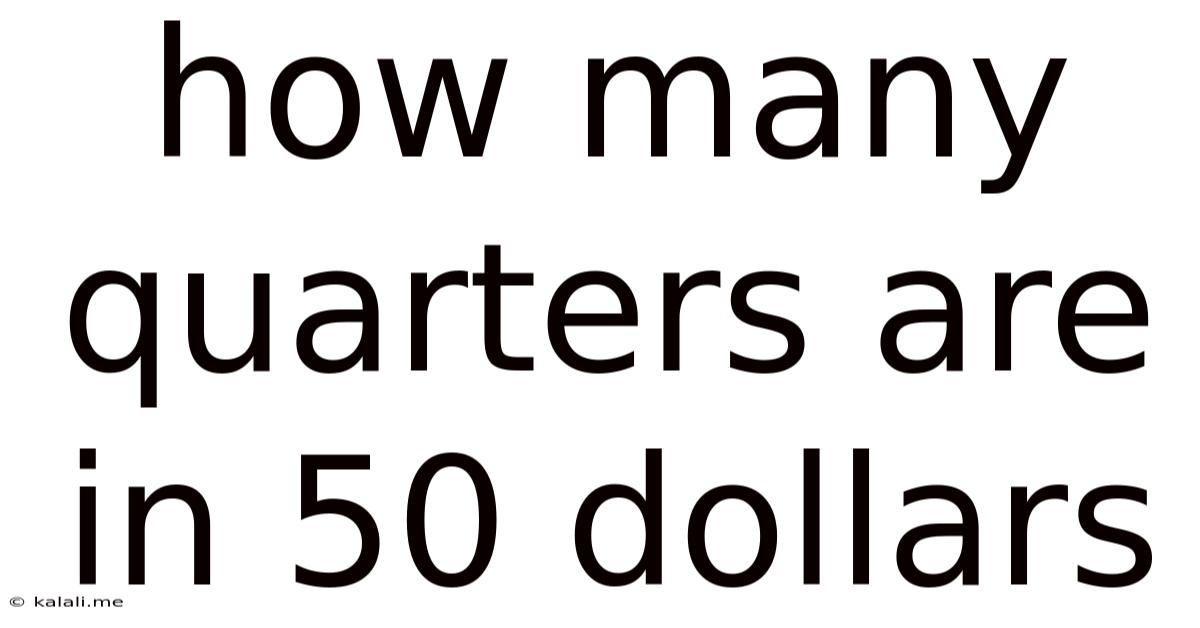How Many Quarters Are In 50 Dollars
Kalali
Jun 29, 2025 · 4 min read

Table of Contents
How Many Quarters Are in $50? A Deep Dive into Currency Conversions
This seemingly simple question, "How many quarters are in $50?", opens a door to a fascinating exploration of American currency, mathematical concepts, and even some practical applications in everyday life. While the basic calculation is straightforward, we'll delve deeper, exploring different ways to approach the problem, highlighting potential real-world scenarios, and touching upon related financial literacy concepts. This comprehensive guide will provide not just the answer, but a complete understanding of the subject.
Understanding the Foundation: Quarters and Dollars
Before tackling the main question, let's establish a firm foundation. The US dollar ($) is the official currency of the United States. It's subdivided into smaller units, including cents (¢), nickels (5¢), dimes (10¢), quarters (25¢), half-dollars (50¢), and dollar coins ($1). This article focuses on the quarter, a coin representing one-fourth (or 25%) of a dollar. This is the key piece of information needed to solve our central problem.
The Simple Calculation: Finding the Number of Quarters in $50
The most direct approach is a simple division problem. Since one quarter is worth $0.25, we can determine the number of quarters in $50 by dividing the total dollar amount by the value of a single quarter:
$50 / $0.25 = 200 quarters
Therefore, there are 200 quarters in $50.
Beyond the Basics: Exploring Different Approaches
While the direct division method is efficient, let's explore alternative approaches that showcase different mathematical skills and perspectives:
- Using Proportions: We can set up a proportion to solve this problem. If 1 quarter is equal to $0.25, then how many quarters (x) are equal to $50?
1/0.25 = x/50
Cross-multiplying, we get:
0.25x = 50
Solving for x:
x = 50 / 0.25 = 200 quarters
This method reinforces the concept of equivalent ratios and is useful for solving similar problems involving different currency denominations.
- Using Unit Conversion: This approach emphasizes the conversion between units. We start with $50 and convert it to cents:
$50 * 100 cents/$1 = 5000 cents
Then, we divide the total cents by the number of cents in a quarter:
5000 cents / 25 cents/quarter = 200 quarters
This method highlights the relationship between dollars and cents and reinforces the concept of unit conversion, a crucial skill in various scientific and mathematical applications.
Real-World Applications and Scenarios
The knowledge of converting dollars to quarters extends beyond simple arithmetic. Here are some real-world scenarios where this skill proves useful:
-
Counting Inventory: A business owner might need to count their quarter inventory. Knowing the conversion helps them quickly estimate the total value based on the number of quarters.
-
Fundraising: Schools and charities often collect change, including quarters, during fundraising drives. Understanding the value of a quantity of quarters is essential for tracking fundraising progress.
-
Coin Operated Machines: Many vending machines, laundromats, and arcade games operate using quarters. Knowing how many quarters are needed for a specific amount helps save time and effort.
-
Saving Money: Tracking savings in quarters can be a fun and visual way, especially for children, to learn about saving money. Counting the quarters and converting them to dollars reinforces the concept of accumulating wealth.
-
Financial Planning: While not directly related, this skill provides a foundation for understanding larger financial concepts like budgeting, investing, and managing personal finances. It enhances numerical fluency and problem-solving abilities which are essential for better financial decisions.
Expanding the Scope: Working with Other Coin Denominations
The principles used to calculate the number of quarters in $50 can be extended to other coin denominations. For example:
- How many dimes are in $50? $50 / $0.10 = 500 dimes
- How many nickels are in $50? $50 / $0.05 = 1000 nickels
- How many pennies are in $50? $50 / $0.01 = 5000 pennies
This illustrates the inverse relationship between the value of a coin and the number of coins needed to make up a specific amount.
Addressing Potential Challenges and Misconceptions
While the calculation is straightforward, some potential challenges and misconceptions might arise:
-
Decimal Point Errors: Incorrect placement of the decimal point during division can lead to inaccurate results. Careful attention to detail is crucial for accurate calculations.
-
Confusing Denominations: Mistaking the value of a quarter with other coin denominations can also lead to errors. Clear understanding of the currency system is essential.
-
Large Numbers: Working with large numbers might require additional steps or the use of a calculator to ensure accuracy.
Conclusion: The Value of Understanding Currency Conversions
The seemingly simple question of "How many quarters are in $50?" provides a practical entry point into the world of currency conversions and mathematical applications. Beyond the straightforward answer of 200 quarters, this exploration highlights the importance of understanding basic financial concepts, applying various mathematical approaches, and recognizing the real-world applications of these skills. This knowledge is not just valuable for simple everyday tasks, but it also forms a strong foundation for more complex financial literacy and problem-solving abilities. The ability to confidently convert between different currency denominations is a valuable life skill with broad applicability.
Latest Posts
Latest Posts
-
How Many Minutes Is 7 Miles Driving
Jun 29, 2025
-
How Many Oz In Pint Of Blueberries
Jun 29, 2025
-
Is Clifton Powell Related To Eddie Murphy
Jun 29, 2025
-
How Many Square Feet Is The United States
Jun 29, 2025
-
What Is The Penalty For Killing A Buzzard
Jun 29, 2025
Related Post
Thank you for visiting our website which covers about How Many Quarters Are In 50 Dollars . We hope the information provided has been useful to you. Feel free to contact us if you have any questions or need further assistance. See you next time and don't miss to bookmark.